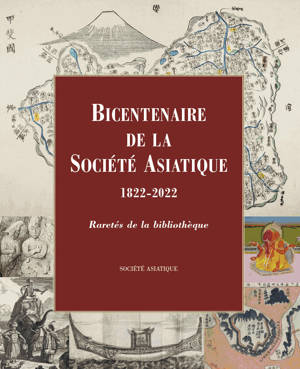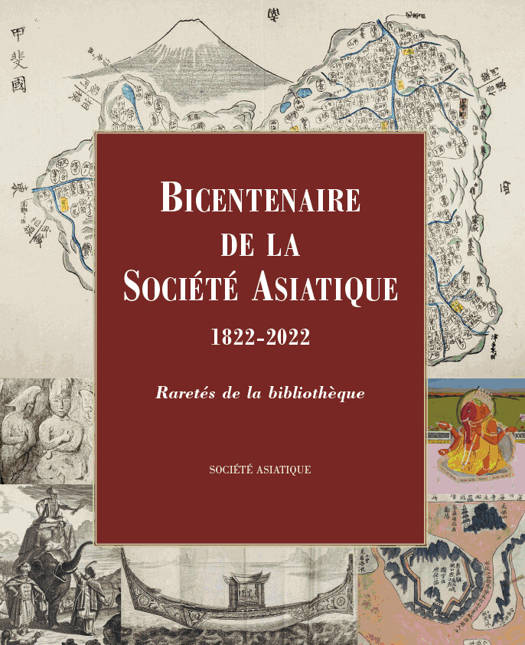
- Retrait gratuit dans votre magasin Club
- 7.000.000 titres dans notre catalogue
- Payer en toute sécurité
- Toujours un magasin près de chez vous
- Retrait gratuit dans votre magasin Club
- 7.000.0000 titres dans notre catalogue
- Payer en toute sécurité
- Toujours un magasin près de chez vous
Bicentenaire de la Société Asiatique 1822-2022
Raretés de la bibliothèque. Catalogue de l'exposition au Collège de France, 29 novembre 2022 - 15 janvier 2023
Peeters Publishers
Livre broché | Français
70,00 €
+ 140 points
Description
Under the comforting aspect of a lavishly illustrated erudite collection, this album is a treasure hunting license. Not for breaking through walls, but for breaking enigmas. No need to break into the secret corridors of the Pyramids, to enter the mazes of the Maharajas' palaces! We can stay on the 'Left Bank', where the Societe Asiatique, open to those who ask, has not ceased, for two centuries, to enrich its library, durably marked by the memory of Jeanne-Marie Allier, daughter of the great sinologist Paul Demieville. When the Societe Asiatique was founded on April 1st 1822, Paris was the European capital of research on the Orient. Until then, the Near East and Asia had been the exclusive domain of missionaries and merchants, whose zeal was not entirely disinterested. Anquetil-Duperron (1731-1805) was the first orientalist in the scholarly sense of the word, that is to say 'a true traveler, loving all men as his brothers, sailing all over the world, above wealth and poverty'. Since the Egyptian expedition, the horizon had opened on the depths of Asia. Orientalists discovered a world even more captivating than the amusing utopias of Gulliver's Travels. Certainly, no Asian people wrote diagonally, like Lilliputians or the English ladies. But how can one not marvel at the variety of media? Books, charters and scrolls, clay tablets, casts of lapidary inscriptions, papyri, Chinese xylographs, and leaves of exotic trees covered with Buddhist texts, all flowed in to the Societe Asiatique, . Later, when ethnologists began collecting unwritten languages, they sent their transcriptions, hastily noted down on bags of cement. Both present at the first session of the Societe Asiatique, Abel-Remusat and Champollion faced the same challenge at the opposite ends of Asia: to decipher ideograms with the help of bilingual texts, Sino-Manchu on the one hand, Greco-Egyptian on the other. Printing the Journal Asiatique required special characters. The quest for these new fonts is a kind of adventure novel, in which we meet Armenian merchants leaving for Egypt, Tsar's ambassadors in Manchuria, skilled engravers, and even the generosity of the King of Prussia, donor of the Devanagari letters. The Imprimerie Nationale took over under the Second Empire. The library of the Societe Asiatique mirrors the fervor of thousands of Orientalists who have shared the same humanist and universalist project for two centuries. Each work bears the memory of a scholar. The Chinese Herbarium reflects the insatiable curiosity of the founder, Count de Lasteyrie. The Lalita Vistara manuscript is linked to the work of Eugene Burnouf. The charming popular Chinese images are a gift from Edouard Chavannes.' Truth is in the whole', wrote Hegel. At a time of narrow specialization and excessive compartmentalization, the present collection opens up a space for universal reflection and citizenship.
Spécifications
Parties prenantes
- Auteur(s) :
- Editeur:
Contenu
- Nombre de pages :
- 298
- Langue:
- Français
Caractéristiques
- EAN:
- 9789042943421
- Date de parution :
- 29-11-22
- Format:
- Livre broché
- Format numérique:
- Trade paperback (VS)
- Dimensions :
- 240 mm x 300 mm
- Poids :
- 6799 g

Les avis
Nous publions uniquement les avis qui respectent les conditions requises. Consultez nos conditions pour les avis.






